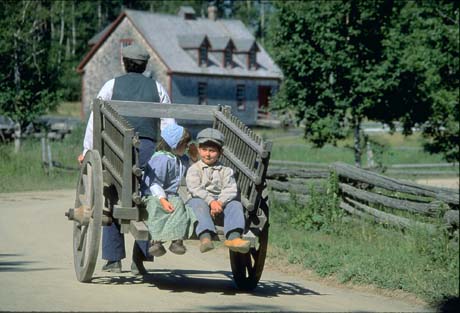|
|
When’s
a Cajun an Acadian? Most of us are familiar with the Cajuns and their distinctive music, cuisine, language, and traditions. And surely no visit to Louisiana can really be considered complete without tasting Cajun treats like “po’boys,” blackened catfish, or spicy jambalaya; or taking in a concert of “down home” Cajun fiddling. Although the Cajun experience can be sampled there, New Orleans is not really the centre of their culture, as it is mainly the home of Louisiana’s other major group of French origin, the city-dwelling Creoles. However, not too far away, in the rural bayou country surrounding the town of Lafayette, the Cajun heart still beats strongly. But where did the Cajuns live before reaching the South, and why did this French-speaking people come to settle there in the first place? |
|||
In fact, the name “Cajun” derives from “Acadian.” The Acadians are a people who originated in France, and settled the East Coast of what is now Canada beginning in the 17th century when it was still a French colony. In their dialect, the word they use for themselves, “les Acadiens,” actually sounds like “Cajuns.” and this is what they came to be called after being expelled from Atlantic Canada and eventually settling in Louisiana during the later part of the 18th century. People on both sides of the Canada-U.S. border may be a little sketchy about the historical events that led the Acadians to become Cajuns. Today, most of Canada’s Acadians can be found in the three eastern provinces of Nova Scotia, Prince Edward Island, and especially New Brunswick. In order to learn more about this history and the modern Acadian identity, I had the opportunity to travel through the Acadian heartland of New Brunswick as the guest of the province’s tourist board. What I experienced there left me with a great appreciation of Acadian history and culture, and a profound admiration for the Acadian people’s commitment to their traditions and their survival over the centuries. Crossing the provincial border between Quebec and New Brunswick after driving through the stunning countryside surrounding Lake Témiscouata, I stopped at the tourist board office near Edmundston in the northwestern part of the province where the friendly staff greeted me in both French and English. This town of approximately 100,000 inhabitants is located on the scenic Madawaska River, and is over 90 per cent French speaking. But most people are completely comfortable speaking English as well, and will gladly welcome visitors to their unique corner of the province in either language. New Brunswick is in fact Canada’s only officially bilingual province. Although both English and French are recognized as official languages at the federal level in Canada, New Brunswick to date is alone among the country’s 10 provinces which actually promotes the use of both languages among its residents. The result, for this envious Canadian from mainly English-speaking Ontario, is a model of what the country should be. And it is a tribute to the determination of the Acadians’ desire to hold on to their language and traditions despite great pressure to blend into the English-speaking majority. As a result both languages flourish in New Brunswick to this day. Edmundston and the region surrounding it are sometimes half-humorously referred to as the “Republic of Madawaska”. This entity has no official existence now, but surfaced briefly during the 1840s as a result of a little-known border dispute between the United States and Britain when Canada was still under British rule. Negotiators from both countries had been unable to determine the exact boundary between Maine and New Brunswick, since the area was then a remote and largely uninhabited wilderness, covered in vast stands of white pine and other trees in great demand for the shipbuilding industry. As a result of the confusion, loggers and their families living near the Madawaska were not really sure whether they were Americans or subjects of Great Britain. When one local resident was asked what his nationality was, he proudly declared that he was a citizen of “la république de Madawaska,” the republic of Madawaska, and the name stuck. People living in the area were a mixture of aboriginal people, settlers of English, Scottish, and Irish stock, transplanted Americans, French-speaking Quebecers, and Acadians. Today’s Madawaskans like to claim that they were the world’s first multicultural society! After a period of tension when loggers from both sides of the border briefly clashed over forest rights, in 1842 the United States and Britain signed the Webster-Ashburton Treaty, which clearly placed most of the “republic of Madawaska” inside New Brunswick. But people in the region keep their old traditions and identity alive to this day. Every July Edmundston hosts the Foire Brayonne, eagerly attended by fellow Madawaskans from Maine. On that occasion, the republic’s flag, which includes the American eagle among other symbols, is proudly flown. Madawaskans’ nickname for themselves is les brayons, a French word that originally referred to a wooden tool used for cleaning and brushing flax. But according to one source, it was first used in a letter a soldier sent home from France during the First World War, which was published in the local newspaper, Le Madawaska. In that letter, the serviceman wrote that the charms of the French girls he had seen could not compare with “the soft features of our Brayonne ladies from Madawaska.” The word “Madawaska” itself in the native Mi’kmaq language means “home of the porcupine”, perhaps an apt title for a people who can sometimes be a little prickly about their local identity! While having a pleasant lunch in the recently opened New Brunswick Botanical Garden, just outside Edmundston, I had the opportunity to try one of the local Madawaskan delicacies, called “ployes”, a kind of pancake made from buckwheat flour. Even though the weather was rainy and unseasonably cold, my tour of the garden was fascinating. Daniel Bélanger, a botany professor at the Edmundston campus of the University of Moncton, guided me around the grounds, enthusiastically pointing out the various examples of provincial trees and flowers growing there, and encouraging groups of students who were creating an elaborate floral mosaic to be displayed in an upcoming international competition. That night, I was the guest of Valmont Martin and Francine Landry, the owners of the charming Auberge Les Jardins, an inn located on the outskirts of Edmundston, just off the Trans-Canada highway. Each one of the ten cozy rooms in the inn is named for a Canadian province, and, fittingly enough, I was given the Ontario room. The inn is famous for its excellent cuisine and well-stocked wine cellar. Valmont proudly informed me that thanks to the hard work of the sommelier, his son Christian Landry, his establishment had recently received a much-coveted citation in the prestigious Wine Spectator magazine. Dinner was truly delicious, including a juicy roast of bison raised on a nearby farm and a sampling of memorable vintages from Valmont’s wine cellar. Accompanying me through the meal were two local representatives of the provincial tourist board, who carried on a friendly conversation between themselves in French while effortlessly switching to English when they chatted with me about the many interesting sites that one can visit in their “république.” After a fascinating discussion of les brayons and their intense pride in their local history and culture, the first day of my journey into Acadia came to a very pleasant conclusion. The next morning, I drove through the green, rolling countryside of the St. John River Valley, en route to my next stop, the city of Moncton, home of the province’s main French-language educational institution, l’Université de Moncton. Moncton is New Brunswick’s second-largest and fastest-growing city, as well as an important centre of Acadian culture. On the university campus, there is a museum dedicated to the history of the Acadian people, from the time of their first arrival as colonists in what is now Nova Scotia, up to the present day. In addition, the university offers a number of programs in Acadian studies and is a major research centre, publishing books on Acadian history and culture. The name “Acadia”, which originally referred to the rich lands along the banks of the Bay of Fundy, is thought to come from the native Miq’ma word for their land. But another possibility is that it is a corruption of the name “Arcadia,” which to the classical Greeks and Romans symbolized an idyllic rural utopia. The first French settlers must certainly have been favourably impressed by the mild climate and bountiful resources of their new homeland, a sharp contrast with the harsh conditions they had experienced elsewhere in their travels. For well over a century, the Acadians flourished, practicing fishing and farming, and developing innovative techniques for draining the low-lying tidelands of the Bay of Fundy and turning them into fertile pastures for their crops. All the while, they struggled to maintain an uncertain neutrality in the ongoing conflicts between the French colonial authorities based in distant Quebec and their British and American rivals in the 13 colonies to the south. |
||||
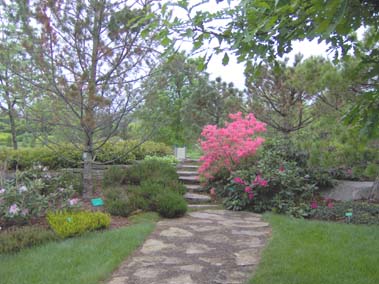 |
||||
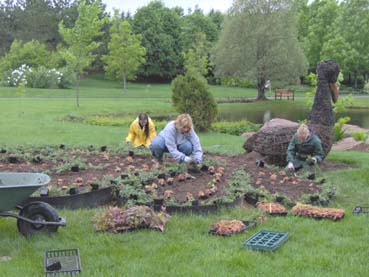 |
||||
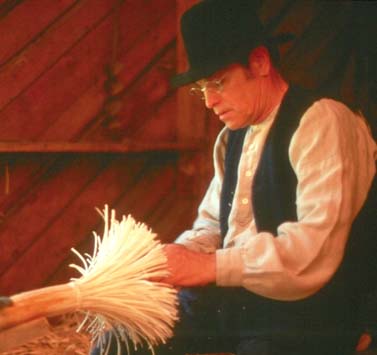 |
||||
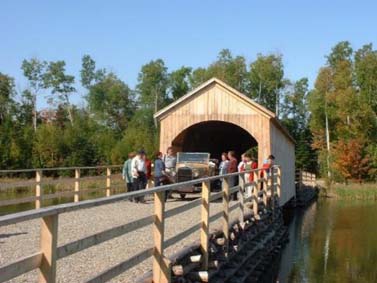 |
||||
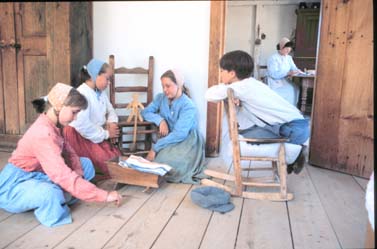 |
||||
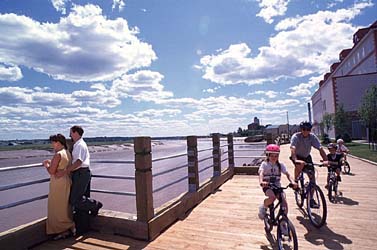 |
||||
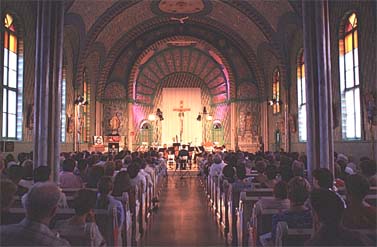 |
||||
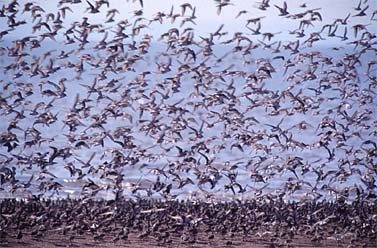 |
||||
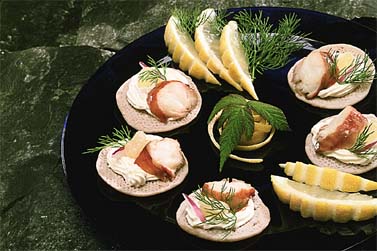 |
||||
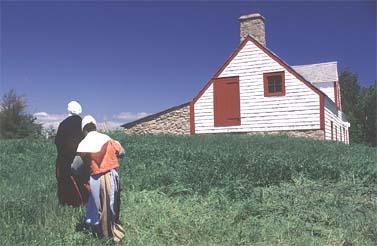 |
||||
In 1713, following France’s military defeat in Queen Anne’s War, Acadia was ceded to Britain under the terms of the Treaty of Utrecht. While the new rulers were content to permit the Acadians to continue to practise their Roman Catholic religion and speak their French language, many New England colonists in neighbouring Massachusetts were looking north to the Bay of Fundy as a region for expansion. The American colonies were feeling the pinch of a population explosion, and they resented the fact that their British rulers were permitting a French-speaking, Catholic people to occupy lands they felt should by right be theirs. Eventually they gained a sympathetic ear from the British Governor, Charles Lawrence, who was becoming increasingly suspicious of the Acadians’ loyalty should yet another war break out with France. The year 1755 represents a tragic turning point in the history of the Acadian people and is etched painfully in their collective memory to this day. In the early summer of that year, Governor Lawrence called a group of prominent Acadian community leaders together and basically presented them with an ultimatum. Either they could swear an oath of loyalty to Britain, which would require them to abandon their Catholic religion, or they would face immediate expulsion from their homeland. While some reluctantly took the oath, most Acadians refused to comply. As a result, British redcoats, aided by colonial militias from Massachusetts, began the systematic removal of the Acadians from their villages. Many consider this to be the first example of what has come to be known as “ethnic cleansing” in history. Within a few years, thousands of Acadians were forced into exile, some returning to France while others chose an uncertain new life in the 13 colonies to the south. There, the British hoped, they would be quickly assimilated into the dominant English-speaking, Protestant society, abandoning once and for all their French language, Roman Catholic faith, and traditional Acadian identity. This tragic and traumatic event in Acadian history is known to this day as le grand dérangement (the great upheaval). A century later, the great American poet Henry Wadsworth Longfellow would immortalize it in his widely read epic poem “Évangeline.” Within a few decades of their deportation, scattered Acadian communities in Georgia and the Carolinas heard rumours that the new Spanish authorities in the previously French colony of Louisiana were looking for people to settle there. In Louisiana, the Acadians would be permitted to practise their religion and continue to speak their language. On learning this, many decided to make the arduous trek from the eastern seaboard to the bayous of the Mississippi, where they found their second North American home. There they were able to adapt their skills in fishing and farming to a new way of life in unfamiliar surroundings. Within a few generations, they had become “Cajuns,” and while some did eventually return to their ancestral homeland in Atlantic Canada, the majority remained in Louisiana, adding their own distinctive flavour to the cultural gumbo, or mixing of peoples that the state rightly continues to celebrate to this day. Those Acadians who did decide to return to British North America in the years after the American Revolution found that new, English-speaking settlers were now occupying the lands that had once been theirs. As a result, they were forced to find new homesteads in less desirable parts of New Brunswick, which the British had set up as a separate colony for United Empire Loyalists fleeing the newly independent United States in 1784. The Acadians resettled along the banks of the Petitcodiac River in the region surrounding Moncton, and in the far northeastern tip of the province, including the communities of Shippagan, Caraquet, and Bathurst. Many now consider this area to be the real heart of Acadia. In the town of Memramcook, a short drive south of Moncton, the contemporary Acadian identity is proudly on display. Most of the telephone poles have been painted in the colours of the Acadian flag – red, white, and blue. At the Monument Lefèbvre, named after a 19-century parish priest who did much to promote Acadian culture and traditions, there is another museum dedicated to the preservation of their history. An informative and moving video tells the story of the Acadians’ forced expulsion from their homes and their eventual return. The building housing the museum was formerly known as Collège Saint-Joseph, the first French-language degree-granting institution in Atlantic Canada. Memramcook also hosted the first Acadian congress in 1889, where delegates adopted a flag and anthem, and proclaimed their intention of seeking full recognition for their language, culture, and religion within New Brunswick and the newly formed Dominion of Canada, which had gained limited independence from Britain in 1867. The Acadian Museum in Moncton honours the achievements of a number of individuals who have promoted the survival of the Acadian people over the centuries. One of the most significant modern figures in Acadian history is Louis Robichaud, who served as the premier of New Brunswick during the 1960s, the first Acadian to hold this post. Under his administration, the Université de Moncton was established as the first French-language institute of higher education in the province. Robichaud did much to advance the linguistic and cultural rights of Acadians, as well as leading by example in raising the status and profile of his people throughout the province. Like their Louisiana cousins, the Cajuns, the Acadians had frequently been viewed as “hewers of wood and drawers of water,” that is, as poorly educated, second-class citizens who were not really capable of assuming high positions in society, government, or business. Robichaud changed all that, and as a popular, charismatic leader, he could in some ways be compared to Huey Long, the populist governor of Louisiana during the 1930s, who although not a Cajun himself, did much to improve their social conditions during his time. To this day, the Acadians of New Brunswick fondly remember ’tit Louis (little Louis) and the role he played in winning greater respect for them among the province’s English-speaking population. On the third day of my journey, I visited another site that preserves the traditions of the Acadian people, and especially one great writer, located in the picturesque fishing village of Bouctouche, just north of Moncton. This is “Le Pays de la Sagouine” (the land of la Sagouine). It pays tribute to the writings of Antonine Maillet, an Acadian author who won the prestigious French literary award the Prix Goncourt in the 1970s, the first non-French novelist to do so. Maillet’s books deal with themes in Acadian history and culture, especially the people’s experience in the years following their expulsion from their original homeland. The novel for which she received the award, Pélagie-la-Charette, tells the story of an indomitable woman known as Pélagie, who leads her people from the bayous of Louisiana back to Atlantic Canada on a magic wagon. Maillet’s other famous book, which has been made into a popular play, is La Sagouine, a one-person monologue on various themes of Acadian life, culture, and traditions, delivered by a plain-speaking, humorous, and occasionally risqué washerwoman, “la Sagouine”, or wise woman. For over 30 years, the indomitable Viola Léger has brought this role to life, in both French and English, and in recognition of her dramatic contributions to Acadian life she was appointed to the Canadian Senate in 2001. At le Pays de la Sagouine, you can visit a number of different sites that recreate aspects of Acadian life during the 19th century, including stores, workshops, and traditional homesteads. At each one, people in costume act out the roles of various figures in the village, such as housewives, bakers, storekeepers, blacksmiths and carpenters, conversing with visitors in both English and French. One of the most dramatic and impressive parts of the site is the small island where local actors stage versions of la Sagouine and other plays relating to Acadian life during the summer months. The audience sits outdoors on benches arranged in the style of a Greek amphitheater, in order to witness the theatrical productions, which can include the burning of Acadian villages by British troops during the time of the expulsion. While there are many historical theme parks that can be visited throughout North America, I am not familiar with any that focus so much on the life and writings of a single literary figure. Le pays de la Sagouine not only serves to perpetuate the traditions and historical memory of the Acadian people, but also testifies to the immense significance of Antonine Maillet as one of its principal recorders and story-tellers. Travelling north through the Miramichi region of eastern New Brunswick, I passed through a number of towns and villages, whose names usually indicated whether French or English was the predominant language spoken there. New Brunswick is the only province in Canada where the English-French split is roughly 50-50, and this is one reason why it is officially bilingual. Late in the afternoon, I arrived in the northeastern part of the province, widely regarded today as the heartland of Acadia. The economy of this region is largely dominated by fishing and tourism. In the fishing port of Shippagan I visited an aquarium where a wide variety of species of marine life was on display. Luckily, I arrived in time to see the daily feeding of the aquarium’s seals. An extremely interesting and informative video detailing the history of fishing in the area is regularly screened in the aquarium’s auditorium. Fishing remains the lifeblood of the community, and Shippagan fishermen catch lobster, snow crabs, and other marine delicacies that find their way to tables in restaurants and homes throughout Canada and the United States. My base for exploring this region was the nearby seaside town of Caraquet, which has been a popular tourist destination for over a century. Here I had the pleasure of staying in the Hotel Paulin, whose owner, Gérard Paulin, is the third generation of the family to manage the establishment. His wife, Karen Mersereau, originally from Toronto, is a master chef who is in charge of the hotel’s renowned restaurant. The Hotel Paulin is a homey, comfortable place that has preserved the atmosphere of a 19th-century inn, complete with period-furnished rooms, an attractive front parlour where drinks are served, and a lobby decorated with old prints and photographs. One of the most remarkable of these is a picture which Gérard believes was taken in the early years of the 20th century, depicting a number of gentlemen enjoying a drink at the bar (long since removed). One of them, his grandfather, bears an uncanny resemblance to Gérard himself, complete with handlebar moustache and serious expression. Religion has always played an important role in Acadian society,
and although church going may have declined in recent years, the Roman
Catholic faith is still a vital presence in this part of New Brunswick.
Near Shippagan, on Lamèque Nearby Grand-Anse boasts North America’s only museum dedicated to the Popes, from St. Peter all the way to Benedict the XVI. The museum’s founder, Edmond Landry, has amassed an impressive collection of art, costumes, and other treasures that detail the history of the papacy from ancient times up to the present. One of its most interesting features is a scale model of St. Peter’s Basilica and the surrounding square in Rome, entirely made of wood, which is believed to have been originally exhibited at the St. Louis World’s Fair. A vast portrait gallery contains pictures of all 265 pontiffs, and the entire museum is an eloquent testimony of the Acadian people’s strong identification with the Catholic Church. New Brunswick is home to many museums chronicling Acadian history and way of life, but by far the most important is the Acadian Village in Caraquet. Still under construction, it is designed to provide visitors with a time machine like trip into the past, from the return of the Acadians to their original homelands in the late 18th century up to the eve of the Second World War. The village is staffed by dozens of local people who act as interpreters in period costumes demonstrating how ancestral trades and customs were practiced at the time. On my visit I saw a woman carding and spinning wool recently shorn from the sheep grazing outdoors, and another baking bread and preparing a delicious vegetable soup for the family lunch. The local sawmill was in operation, as was the tavern, where I chatted with the bartender over a welcome glass of beer after my visit. It is possible to sample delicious Acadian home cooking at la table des ancêtres (the table of the ancestors), where local delicacies like râpé (also know as “rappie pie” a kind of potato cake), hearty homemade soups, seafood, and a delicious blueberry cobbler can be sampled. One of the most intriguing features of the village is its fully functioning hotel, the Chateau Albert, a turn-of-the-century hostelry that once stood near the Hotel Paulin in Caraquet. It has been entirely moved on to the site of the Acadian Village, and it offers weekend getaway packages to couples curious to experience early 20th-century accommodation. The hotel has no TVs or Internet connections, and the only working telephones are of the early 1900 era. However, the food and beverages served in the well-appointed dining hall are outstanding, and guests are transported across the grounds of the village to their period rooms (and waiting period flannelette nightgowns!) in a vintage Model T Ford! After a very busy day of sightseeing around Caraquet, I returned to the Hotel Paulin for a pre-dinner rest. Earlier that day, Karen had asked if I had any special requests for dinner. Luckily for me, although perhaps less so the owners, I happened to be the only guest staying there that evening. Poor weather had led to cancellations from other anticipated arrivals, and as a result I had the pleasure of visiting Karen, Gérard, and their delightful and energetic young son Gilles-Gérard almost as a member of the family. I had requested seafood, a sensible choice in this part of the world, and the dinner Karen prepared for me that evening will without a doubt live on in my memory for years to come. I started with a bouillebaisse prepared entirely prepared with local delicacies such as mussels, scallops, and shrimp. The second course was a snow-crab salad served with mango and avocado. But the pièce de résistance was certainly the main course, an entire lobster steamed (not boiled) in champagne, with a creamy champagne sauce served on the side instead of the usual drawn butter. To accompany each course, Karen had selected an appropriate wine. Since the only two diners that evening were myself and Percy Mallet, my pleasant and knowledgeable Acadian guide from the provincial tourist board, she took time to visit with us and gauge our delighted reactions to the feast she had prepared. Dessert was a tart with a maple syrup cream filling, topped with local blueberries. During the meal, Percy showed great patience and impressive savoir-faire in instructing me in the finer points of eating lobster in the Acadian way. He told me that many English North Americans leave much of the crustacean on their plates, simply because they do not know how to remove the meat of the lobster from its hard outer shell. Percy explained to me that during the hard times of the Great Depression, when prices for lobster were at rock bottom, it became the food of the poor, and for this reason none of it was allowed to go to waste. It is a tradition that has continued at Acadian dinner tables to this day, and as a dedicated lobster eater, I was immensely grateful for the lesson! It was with decidedly mixed emotions that I left the Hotel Paulin and my friendly, welcoming hosts for the last leg of my trip across northern New Brunswick en route to Quebec City and Montreal. Karen had arranged for Gérard to drive me to a local cheese factory that morning, where I stocked up on some delicious locally produced cheeses, including Brie, Chèvre, and Camembert. Along with these, Karen thoughtfully packed me a picnic lunch, including herring fillets, smoked meat, bread, and a small bottle of wine, which I enjoyed on the road, despite the incessant rain. My route took me along the shore of the Bay of Chaleurs, as far as Bathurst, the largest city in the Acadian peninsula. From there I turned inland, driving across a remote and thinly settled forest region to the small town of St-Quentin. Along the way, I saw two female moose grazing by the roadside, patiently waiting for me to stop so that they could cross the highway. I had noticed frequent signs warning of the dangers of striking one of these large animals on the road, and from then on I was extremely careful. This was fortunate, for not long afterward I saw a bull moose charging out of the woods, who froze in his tracks at the sight of my oncoming car. After reaching Edmundston in the northwestern part of the province, I retraced my steps back into Quebec, where I spent two delightful nights in the historic cities of Quebec City and Montreal. Although Acadia was the main focus of my trip, I also wanted to experience a taste of Canada’s other, better known French culture and heritage. I stayed in delightful boutique hotels located in the historic centres of both Quebec City and Montreal, and took walking trips of the sights of each city, guided by well-informed representatives of the provincial tourist board. Both Quebec City and Montreal are renowned for their history, museums, art galleries, gourmet restaurants, nightclubs, and thriving cultural life. While Quebec City preserves more of its traditional ambience and historic atmosphere, Montreal is a thriving, dynamic metropolis, where French, English, and more recently-arrived inhabitants from all over the world all contribute to its excitement and multicultural atmosphere. My short stay in Quebec also gave me some interesting points of comparison with what I had learned about the Acadians and their history in Atlantic Canada. For almost half a century, Canadians have lived with the very real possibility that a majority of French-speaking Quebecers might someday decide to secede and form their own country. This question has dominated national politics in Canada since the 1960s, and has led to two bitterly contested referenda on the issue, the second 10 years ago resulting in a very narrow margin in favour of the province’s remaining in Canada. The issue remains unsettled to this day. Unlike their Quebec cousins, however, the Acadians of New Brunswick and the other Atlantic Provinces have never expressed any serious desire for national independence. But what they have insisted on is the preservation of their distinct identity and society within Canada, and its recognition from their non-French-speaking compatriots. Every August 15, in Caraquet, Acadians from all over the country gather for an annual celebration called the Tintamarre (Hullabaloo). That date is significant to the Acadians for both religious and nationalistic reasons, since it commemorates both the Roman Catholic Feast of the Assumption and the Acadian national holiday. Thousands of people, many dressed in period costumes and proudly waving the tricolour Acadian flag, line the long main street of Caraquet, for a noisy demonstration of their collective will to preserve their culture and remember their history. At exactly five minutes to six in the evening, or 17:55 using the 24-hour clock, the emotions of the Tintamarre reach a powerful crescendo. For that time signifies the date 1755, when the British redcoats and American militiamen drove them from their homes, burned their villages, and forced them at gunpoint into boats waiting in the harbour. From there they were taken to the 13 colonies, to face an uncertain fate surrounded by a hostile population. However, the Tintamarre is not an occasion for bitterness or the nurturing of ancient grudges, nor is it an angry nationalistic demonstration demanding political independence. Instead, it is a spirited, inclusive, and genuinely friendly celebration of Acadian identity, full of gaiety, music, good food, and dancing. Anyone is welcome, and I have already received my invitation to take part in next year’s festivities. In 2009 Caraquet will also pay host to the World Acadian Congress, held every five years, and attended by Cajuns from the deep south of Louisiana, whose family names, traditions, food, music, and linguistic expressions bear remarkable similarities to their Acadian cousins in Atlantic Canada. Just months after my visit to New Brunswick, Acadians solemnly observed the 250th anniversary of the beginning of the deportations that drove them from their homeland. It was not a moment for anger, resentment, or the settling of old scores. Rather, it was a time for reflection on past suffering and injustice, as well as an opportunity for a proud and determined people to look back on their history, while recalling its tragedies and even more importantly celebrating its triumphs. For the Acadians continue to flourish, both in their traditional northeastern New Brunswick heartland and wherever they have decided to call home. When is a Cajun an Acadian? My answer would be whenever he or she wants to be. And a good place to start would be the Acadian region of New Brunswick, an area that certainly has much to offer anyone interested in learning more about this people and their admirable struggle for survival and peaceful adjustment to changing historical circumstances. To me, the Acadians offer an instructive lesson to other peoples around the world who are striving against difficult odds to preserve and nurture their distinctive ways of life against formidable external pressures. And the fact that they have been able to do so peacefully and without resort to violence is something that is surely worth noting in today’s world. If you go: Information on planning a visit to New Brunswick can be obtained from the province’s official tourist board’s website: Some other useful Web sites of places referred to in this article: Auberge Les Jardins, Edmundston The New Brunswick Botanical Garden, Edmundston A good recent historical work on the expulsion of the Acadians from their homelands is: A Great and Noble Scheme: The Tragic Story of the Expulsion of the French Acadians from their American Homelands, by John Mack Farragher, a professor of American History at Yale University. Photographs courtesy of Peter Flaherty, Le
Village Acadien, and Communications New Brunswick |
||||
